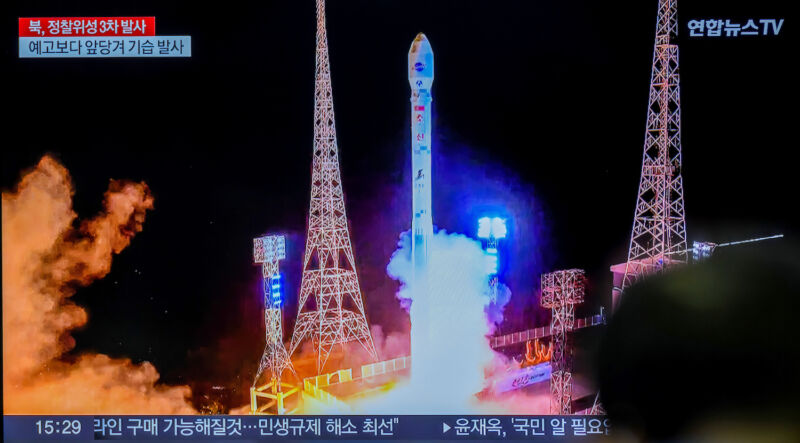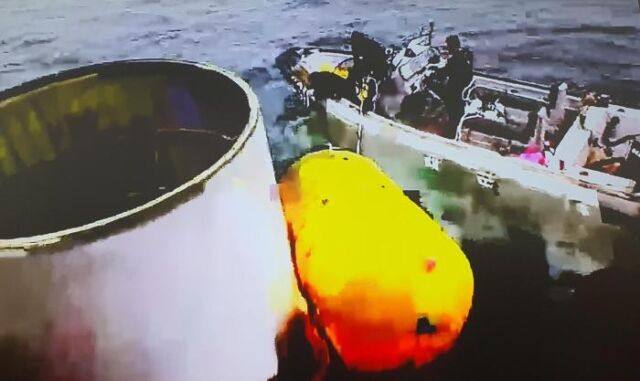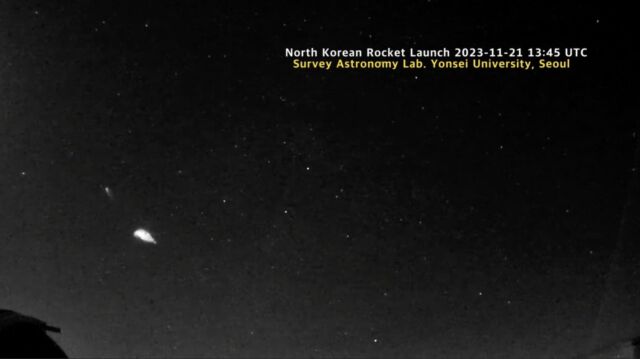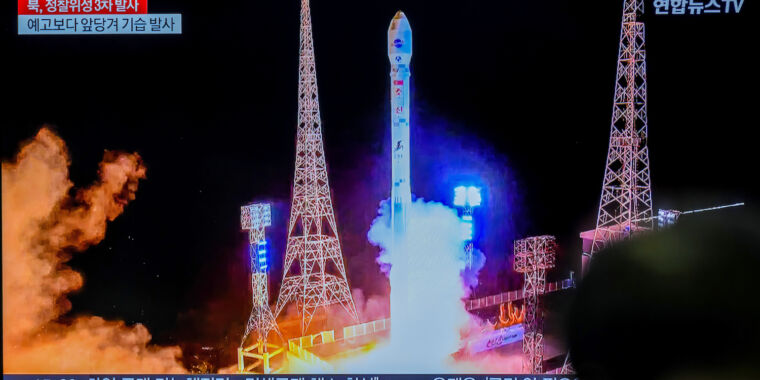[ad_1]

Kim Jae-Hwan/SOPA Photographs/LightRocket through Getty Photographs
North Korea launched a small navy spy satellite tv for pc Tuesday on the nation’s first profitable orbital launch since 2016. This, alone, can be newsworthy, however this launch comes with a twist.
An automatic digital camera operated by Yonsei College in Seoul, South Korea, captured the launch. The digital camera is a part of a worldwide community of all-sky cameras to detect meteors streaking by Earth’s ambiance. On Tuesday night time, it caught a glimpse of North Korea’s Chŏllima 1 rocket climbing greater within the night time sky till its booster engine cuts off. Then an higher stage engine fires to proceed powering its payload into orbit, forsaking the rocket’s spent expendable booster to fall into the Yellow Sea west of the Korean Peninsula.
Then, the night time imaginative and prescient digital camera recorded a brilliant fireball. As an alternative of plunging into the ocean, the booster explodes. It is uncommon to see a spent booster blow up through the launch of expendable rocket, so this raises questions. Did North Korea deliberately explode its rocket?
Falling into the enemy’s arms
The launch Tuesday was the third flight of North Korea’s Chŏllima 1 rocket, which seems to be extra refined than the launch autos North Korea used to deploy its first two profitable satellites in 2012 and 2016. This rocket is probably going based mostly on North Korea’s latest intercontinental ballistic missile, the Hwasong 17, designed to ship nuclear warheads to targets all over the world.
With the addition of an higher stage, the design of which is unknown, the Hwasong 17 may be changed into a satellite tv for pc launcher able to hauling a payload of a number of hundred kilos into orbit. Intelligence officers in South Korea say the brand new missile and the Chŏllima 1 rocket could use engine know-how North Korea acquired from Russia.
It is also potential North Korea could have developed their very own engines that seem much like the Russian RD-250 engine, which consumes hydrazine together with nitrogen tetroxide. When these storable propellants come collectively, they routinely combust, making the engine design comparatively easy and answer for a missile that must be on long-term alert.
North Korea’s first two Chŏllima 1 launches in Could and August led to failure. After the Could launch, South Korean officers mentioned the nation’s navy recovered comparatively massive fragments of the rocket from the Yellow Sea, together with wreckage of the satellite tv for pc onboard the launcher. South Korea’s navy mentioned on the time that it will examine the particles to find out whether or not overseas components, akin to Russian engine know-how, have been used on the rocket.
South Korean officers mentioned the satellite tv for pc had little navy worth, however leaders in Seoul have not mentioned whether or not their inspections of the rocket revealed any new particulars about potential Russian involvement within the North Korean rocket program.
However, Shin Received-sik, South Korea’s minister of nationwide protection, pointed to warming relations between Russia and North Korea, together with a gathering between Russian President Vladimir Putin and North Korean chief Kim Jong Un at a Russian spaceport earlier this 12 months. Kim and Putin mentioned a number of areas of cooperation, together with North Korean ammunition for Russia to make use of in its struggle in Ukraine, and Russian assistance on North Korea’s rocket program.
“Did not the primary and second makes an attempt fail due to engine issues? This time, the largest characteristic is the success of the engine… It exhibits that Putin’s provide to assist in August was not a pretense,” Shin mentioned, in line with Reuters. Whereas there’s some debate amongst analysts and intelligence officers concerning the total involvement of overseas international locations in North Korea’s missile program, it does not appear possible Russia might have provided engines for Pyongyang to make use of on a rocket launch inside lower than three months.

South Korean Navy
It could make sense that North Korea would take the weird step to rig its booster to blow up earlier than falling intact into the ocean, the place South Korean vessels might get well the particles. That appears to be a possible rationalization, in line with analysts who observe North Korea missile launch exercise.
Marco Langbroek, a Dutch archeologist who expertly tracks missile launches on his web site, concluded the booster explosion “might nicely have been deliberate” to maintain the North Korean rocket from falling into the arms of South Korea.
The digital camera that recorded the North Korean launch was developed by Mike Hankey, an novice astronomer and operations supervisor for the American Meteor Society, to watch naturally occurring meteors. They’ll additionally sometimes catch views of area particles and rocket launches, Hankey instructed Ars.
“The stations are designed to work collectively in a community to resolve occasions and trajectories,” he wrote in an e-mail to Ars. “We’ve got about 200 worldwide. That is the primary time we have now recorded a North Korean launch. Additionally, the primary time we have now recorded a detonation.”

Yonsei College
The remainder of the North Korean launch sequence appeared to go in line with plan. The second stage of the Chŏllima 1 rocket continued into area, and a 3rd stage then positioned North Korea’s Malligyong 1 satellite tv for pc into orbit.
North Korea’s state-run information company declared the launch successful, and publicly out there monitoring knowledge from the US navy confirmed this. The navy’s monitoring radars detected the satellite tv for pc in a polar orbit roughly 310 miles (500 kilometers) above Earth.
Photographs launched by North Korea earlier than the launch appeared to indicate the Malligyong 1 satellite tv for pc is concerning the measurement of a fridge, bigger than the satellites North Korea put into orbit earlier than. The satellite tv for pc is designed to take surveillance footage of areas, presumably US and allied navy forces, all over the world. Nevertheless it’s nonetheless too small to offer the highest-resolution reconnaissance imagery collected by spy satellites from the US and different main space-faring nations.
South Korea’s authorities condemned the North Korean launch Tuesday. Shin, South Korea’s protection minister, referred to as the launch a “clear violation” of a UN Safety Council decision banning North Korean launches utilizing ballistic missile know-how. He mentioned the launch was a “critical act of provocation” towards South Korea and the worldwide group.
In response to the satellite tv for pc launch, South Korea mentioned it’s going to droop components of a 2018 navy settlement with North Korea and resume reconnaissance of North Korean navy forces in border areas.
Nov. 22, 2023: This story was up to date with feedback from Mike Hankey and particulars about Russian engine know-how.
[ad_2]
